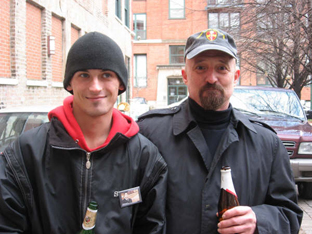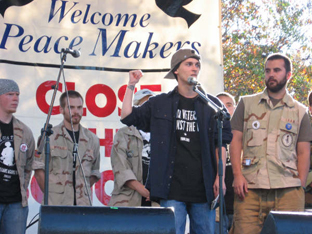 |
VVAW Supports Iraq War Resister Kyle SnyderBy Gerry CondonBarry Romo and Kyle Snyder met on Veterans Day, November 11, 2006. First at the Vietnam Veterans Memorial Wall on the Chicago River in Chicago. Vietnam Veterans Against the War had asked Kyle, AWOL from the Iraq War, to speak at the annual memorial. It was freezing cold. But VVAW was joined by Veterans For Peace, Iraq Veterans Against the War, and many good friends. It was a solemn memorial to honor the warriors and to recommit ourselves to resisting war. Later, Kyle and Barry met again at VVAW's barbecue outside the Vietnam Veterans Art Museum. Somehow Barry and Kyle must have recognized one another. They had both been 19 when they went to war. At 19 years of age, Barry Romo served as an Infantry company commander in the Vietnam War. At 19 years of age, Kyle Snyder was in the Iraq War, escorting officer convoys with a 50-caliber machine gun. It was on one such mission that Kyle saw an innocent Iraqi shot by one of his men.
And Barry and Kyle both said say no to war. Barry returned from Vietnam angry at having been lied to by the US government. An early leader of Vietnam Veterans Against the War, Barry has served as a national coordinator for 35 years. Four months of the Iraq War was enough for Kyle. Profoundly upset by the uninvestigated shooting he had witnessed, he took leave and flew to Canada in search of a safe haven from the war. In Vancouver, British Columbia, Kyle became a popular speaker against the war. He applied to remain in Canada as a political refugee. Once he received his work permit, he worked at a wellness center for children in a small town in Alberta, where he met his fiancé. The Canadian government did not seem eager to welcome Kyle. Canada has never granted refugee status to someone from the US. How could it be possible for the United States, Canada's ally and the "leader of the free world" to persecute its own citizens for their political beliefs? Disturbingly, Canada, which had stayed out of the Iraq War, was sending its troops to join the US war in Afghanistan. After a year-and-a-half of uncertainty in Canada, Kyle was anxious to get on with his life. On October 31, Kyle had turned himself in at Fort Knox, Kentucky. Fort Knox authorities had told his lawyer, Jim Fennerty of Chicago, that Kyle would be quickly discharged from the Army. But once Kyle was in their custody, the Army told him he would have to report to his old unit, the 94th Engineers at Fort Leonard Wood, Missouri. Realizing that he could be ordered back to Iraq or court-martialed and imprisoned, Kyle went AWOL again and began an impromptu speaking tour. His first stop was Chicago. Visit the Vietnam Veterans Art Museum The National Vietnam Veterans Art Museum is little known outside of Chicago. But it is a must visit for all thinking Americans. The artistic expression of Vietnam veterans is at once personal, universal, sometimes beautiful, always profoundly disturbing. On this particular Veterans Day, the Museum hosted a special event. For the first time they displayed the art of a veteran of the Iraq War. Kyle and his fiancé Maleah visited the crowded room to take in the diverse and evocative art of Aaron Hughes. Kyle began to stare at a simple line drawing of an Iraqi horizon, and he froze, not knowing why. His girlfriend Maleah hugged him for a long time. They went outside to the barbecue, where Kyle was comforted by Barry and several other veterans who had a pretty good idea what he was going through. Marty Webster was there. Marty is the VVAW organizer in Cincinnati, Ohio. Kyle, Maleah and I had visited Cincinnati the week before. Marty and his daughter had organized an event for Bob Watada, the father of Ehren Watada, the first officer to publicly refuse to deploy to the Iraq War. When I phoned Marty Webster for directions to the event, he said "you won't have any trouble spotting me." He was right. Marty is big and burly, with grey beard and ponytail. Wearing a jean jacket with VVAW patches, he looked like your Hell's Angel variety of Vietnam veteran. But everyone knows Marty is a teddy bear. He could not hold back the tears as he publicly welcomed Kyle and fellow Iraq veteran/resister Darrell Anderson. Now here was Marty again, comforting Kyle in the courtyard of the Vietnam Veterans Art Museum in Chicago. Ray Parrish was there too. Ray is a Vietnam era vet who has become an indispensable activist for VVAW. Ray dedicates himself to knowing all there is to know about veterans' healthcare, benefits, rights, etc. In particular, he knows a lot about the Post Traumatic Stress Disorder (PTSD) that affects so many veterans. Ray Parrish manifests VVAW's longtime commitment to serving veterans even as they organize against war. Ray Parrish had joined Kyle in a press conference on Monday, the day before the US elections. Kyle had called on the people of Chicago to vote yes for a referendum demanding the withdrawal of US troops from Iraq. The referendum, which was on the ballot in about half of Illinois' counties, passed with an 80% margin. Ray talked to Kyle before and after the press conference. Kyle makes no secret that he suffers from symptoms of PTSD. So Ray put him in touch with another VVAW member, who works in Chicago as a psychotherapist and agreed to see Kyle for an evaluation. It might be helpful, she said, if he were able to document his PTSD. She saw Kyle on several occasions. In lieu of asking a fee for her services, she suggested that when he was able, Kyle make a donation to Iraq Veterans Against the War. This solidarity, on the professional, political and personal levels, were just what Kyle needed at the time. Another longtime leader of VVAW, Bill Davis, offered Kyle transportation and hospitality. Bill's wife, Joan, arranged for Kyle to speak at the high school where she teaches. Kyle had found some really good friends in Vietnam Veterans Against the War. Friends who understood where he was coming from and what he was going through. Friends who were eager to help him in any way they could. Kyle Visits Fort Benning and New Orleans After Chicago, Kyle, Maleah and I headed for the annual protest against the School of Americas at Fort Benning, Georgia, where he met some of his peers in Iraq Veterans Against the War. IVAW had an old school bus, brightly painted with calls for peace. They put on musical performances from the top of their bus and invited passersby to join them. When School of Americas Watch organizers invited Kyle to speak from the main stage outside of Fort Benning, eight members of Iraq Veterans Against the War filed up on stage behind him in a show of solidarity.
Kyle was introduced to the crowd by Col. Ann Wright (ret.), a tireless heroine of the antiwar movement. He and the other Iraq vets received a standing ovation. Backstage was Hannah Frisch with a smile and a hug. Dave Cline, a longtime leader of VVAW who serves as president of Veterans For Peace, was there with words of support. Dave and Kyle first met last summer in Castlegar, British Columbia, at the Our Way Home Reunion of Vietnam War resisters and veterans. Iraq Veterans Against the War invited Kyle, Maleah and I to jump on their bus and head to New Orleans, where they are helping to salvage the Katrina ravaged homes of musicians and veterans. After the Associated Press reported his presence in New Orleans, Kyle experienced the first of several attempts to have him arrested. He had left town just in the nick of time. Kyle returned to Chicago, where the American Friends Service Committee had arranged for him to speak with high school students who were being targeted by military recruiters. Kyle spoke in a dozen of Chicago's poorest high schools, which were predominantly Black or Latino. From the working class, and having lived for a while on the streets, Kyle had no trouble connecting with these students. They knew he was telling the truth, and they hung on his every word. On that second trip to Chicago, Kyle met Barry again at the annual fundraising dinner of a progressive publication. They drank and shared tales of their personal wars and had an outrageously good time. They were from different generations. But the two veterans had become brothers. Hunted by ArmyKyle Returns to Canada Kyle's speaking tour took him next to California. But the Army was on his trail. On December 8, they asked police in Alameda, California to arrest Kyle at a public event in support of war resisters. But Kyle was speaking in San Jose that night. Bob Watada was the speaker in Alameda. Once again, military intelligence proved to be an oxymoron. But Kyle continued to reflect on the possibility of going to prison. He decided he did not want to submit to this injustice. In early January he returned to Canada. He and Maleah decided they would get married and settle in the quaint little town of Nelson, nestled in the mountains of southeastern British Columbia. But the long arm of the US Army reached across the Canadian border and shook him. On February 23, Kyle was arrested by local police, apparently at the request of the US Army. He was released six hour later on orders of Canadian Immigration officials. Quick action by his roommates, a US war resister couple, Ryan and Jenna Johnson, and calls from friendly members of Parliament, secured his release. Why Canadian police would have done the bidding of the US Army is currently the subject of local, provincial and federal investigations (for more on this story, go to www.SoldierSayNo.blogspot.com). Vietnam Veterans Against the War was there for Kyle Snyder once again. They organized a fundraiser to help Kyle with his legal and living expenses. VVAW, along with other veterans, plans to call on the Canadian government to provide sanctuary to Iraq War resisters. VVAW is also asking, "How does the US Army get away with harassing US war resisters in Canada?" This is a story about the importance of personal relationships. It is a story about solidarity among veterans and resisters across generations. Stay tuned for the next installment. United, we are educating our youth about the realities of war. United, we are defending GI's who take a stand against war. United, we can bring a measure of peace to one another as we continue our collective mission: to end the wars of empire once and for all.
Gerry Condon refused Army orders to Vietnam in 1968. He was court-martialed and sentenced to 10 years in prison and a Dishonorable Discharge. But he escaped and fled from the US, living for 6 years in Sweden and Canada where he worked with exiled war resisters against the Vietnam War. When Gerry returned to the US in 1975 campaigning for amnesty for all war resisters and veterans with less-than-honorable discharges, the government dropped his jail sentence. Gerry has been an activist for a just US foreign policy ever since. He currently works with Project Safe Haven, which seeks to secure a Canadian sanctuary for US war resisters. He maintains a website
|



